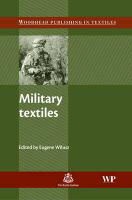Read more
Informationen zum Autor Dr Eugene Wilusz works in the world-famous US Army Natick Soldier Research! Development and Engineering Center in Natick! Massachusetts. He is internationally-known for his research in materials for chemical and biological protective clothing. Klappentext Textiles for military uniforms face a complex set of challenges. They must provide protection, durability and comfort in a wide range of hostile environments. Military textiles reviews the range of recent research on how military clothing can best meet soldiers' needs. The first part of the book reviews general requirements of military textiles, including damage resistance, comfort, sweat management, cold-weather conditions and the integration of high-tech materials into uniforms. Part II concentrates on the protective role of military textiles, covering such areas as high-performance ballistic fibres, textiles for chemical and biological protection, camouflage materials and military fabrics for flame protection. The book also reviews the use of non-woven fabrics and new coatings for military applications. With its distinguished editor and international team of contributors, Military textiles is a valuable reference for those researching and manufacturing military textiles, as well as those interested in the wider area of textiles for protection. Zusammenfassung With an expert editor and international team of authors, this important book, addresses these developments. Chapters discuss key themes such as how fabrics can be tailored to protect against extremes of heat and cold, ballistic impact, and against nuclear, biological and chemical threats. Inhaltsverzeichnis Part 1 General requirements for military textiles: Future soldier requirements: Dealing with complexity; Non-woven fabrics for military applications; Mechanical failure criteria for textiles and textile damage resistance; The sensory properties and comfort of military fabrics and clothing; Testing and analyzing comfort properties of textile materials for military; Sweat management for military applications; Cold-weather clothing; Designing military uniforms with high-tech materials. Part 2 Protection: High-performance ballistic fibres; Ballistics testing of textile materials; Chemical and biological protection; Self-decontaminating materials for chemical biological protective clothing; Camouflage fabrics for military protective clothing; New developments in coatings and fibers for military applications; Military fabrics for flame protection....

